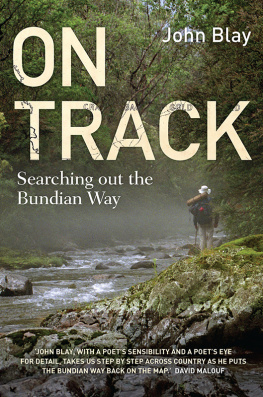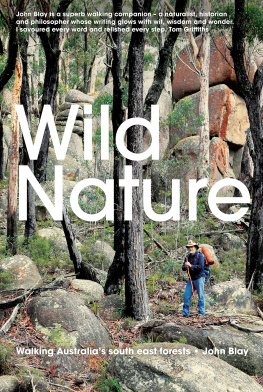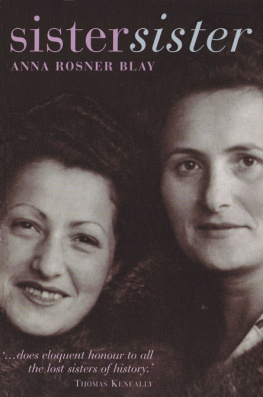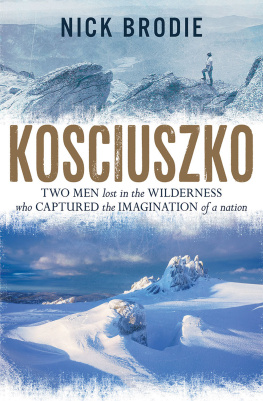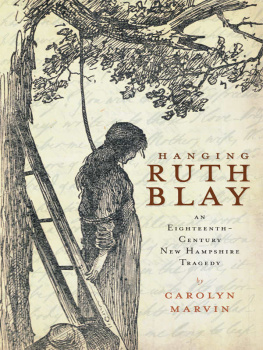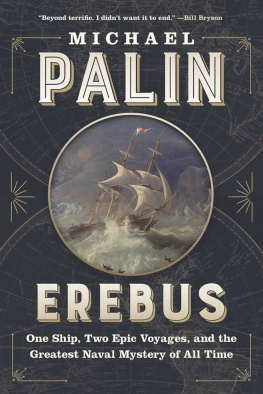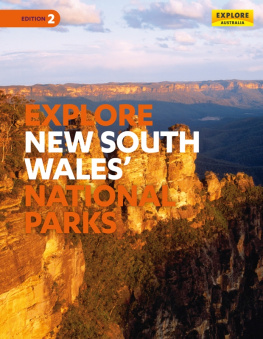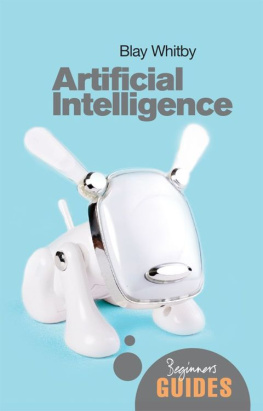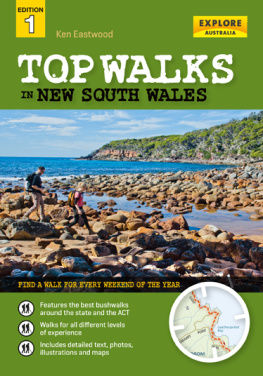
JOHN BLAY is a writer, naturalist and walker. He has written extensively about the bush and its people in poetry, drama and prose. Since 2001, the south-east forests of New South Wales have been the focus of his work, often in association with local Aboriginal communities.

A NewSouth book
Published by
NewSouth Publishing
University of New South Wales Press Ltd
University of New South Wales
Sydney NSW 2052
AUSTRALIA
newsouthpublishing.com
John Blay 2015
First published 2015
This book is copyright. Apart from any fair dealing for the purpose of private study, research, criticism or review, as permitted under the Copyright Act, no part of this book may be reproduced by any process without written permission. Inquiries should be addressed to the publisher.
National Library of Australia
Cataloguing-in-Publication entry
Creator: Blay, John, 1944 author.
Title: On Track: Searching out the Bundian Way / John Blay.
ISBN: 9781742234441 (paperback)
9781742242095 (eBook)
9781742247403 (ePDF)
Subjects: Trails New South Wales.
Aboriginal Australians New South Wales History.
Natural areas New South Wales.
Cultural property New South Wales.
Dewey Number: 333.7809944
Design Josephine Pajor-Markus
Maps Josephine Pajor-Markus and Di Quick, after John Blay
Plant drawings John Blay
Photographs John Blay except Walking the track around the bay
by Blay/Freudenstein
Cover design Sandy Cull, gogoGingko
Front cover image Leaving Geehi. Photo: Blay/Medvecka
Back cover image BJ Cruse explores the Bundian Pass. Photo: John Blay

The following text may contain the names or images of people who are now deceased. Some Aboriginal and Torres Strait Islander communities may be distressed by seeing the name, or image of a community member who has passed away.
The maps in this book are approximate representations of the areas they cover and should not be relied upon by those undertaking walks or visits into these areas.
All reasonable efforts were taken to obtain permission to use copyright material reproduced in this book, but in some cases copyright could not be traced. The author welcomes information in this regard.
In memory of Beryl Cruse
whose intelligence and quiet determination inspired many of us.
They are close observers of Nature and they have an intimate knowledge of the world about them. Surveyors mapping the country, travellers and botanists will receive from them much useful information, given with due modesty and which can be relied upon. This is not surprising, for every geographical point, every brook, every plant, even the different species of these same, have each their own name.
Baron Charles von Hgel, 1833

Acknowledgements
F irst, I am happy to acknowledge the traditional Aboriginal custodians of the land and Elders past and present. Many have spoken with me during the course of my research and I thank them for their support and assistance. Although I aimed to find a better understanding of the place and its people, there is another and greater book, perhaps many, waiting to be told from their point of view. Connection to the land and all that flows from it is at once as deep and mysterious as it is complex. The oldest continent on earth has many tales to tell. Those with connections to country have particular stories of their own, and a great store of knowledge.
Here, in working towards a shared history, I have many to thank for their assistance in helping bring this part to fruition. The New South Wales government generously provided two history research grants that enabled the first and most difficult walking stages. Both Bob Carr and Bob Debus took an interest in the project, and Bob Debuss practical suggestions put me in contact with key players. That financial assistance in the beginning bought extra time in the bush but, before that, ironically, sundry poets set me going in such a strange direction, people like Bob Brissenden, David Campbell and Manning and Dymphna Clark. A conversation with the American Gary Snyder showed me that Australians arent as unique as we thought, while greater depth conversations with Roland Robinson sparked ways to seek out the Aboriginal connection, moving towards the interconnectedness of things, looking more closely at the old ways, and stories. Frank Moorhouse must take the blame for getting me into the bush over an extended time. Others like the ecologists Alec Costin, Alan Fox and my dear old friend and counsel, Dane Wimbush, helped me understand what I found there. Travels with Bill Gammage brought fruitful discourse. And very many of the old-style bushmen I met along the way have a special poetry in their souls, perhaps in spite of, or because of, their solitary consideration of the way of things. Their number includes: Keith Brownlie, Neil Platts, Allan Walker, Barrie Reed, Gordon Platts and Clive Cottrell, to name only a few.
The wit and wisdom of many women have been altogether vital, especially Jacqueline Medvecka for her too-little- acknowledged passion, commitment and transport, Jane Ulman, who got it right from the beginning and has, like a recording angel, hovered over the project with spirit and a true ear, and Leonie Gale for her guidance, bush sense and down-to-earth understanding of conservation and its politics.
Of the many Aboriginal people who have made major contributions I must especially mention Guboo Ted Thomas, Percy Mumbler, Merv Penrith, John Mumbulla, Warren Foster, Darren Mongta, Aileen Blackburn and Beryl Cruse for their sagacity, understanding, wisdom and spirit. Other guides and survey companions en route bringing to light important aspects included Warren Foster, Darren Mongta, Quentin Aldridge, Derek Davison, David Dixon, Dennis Cruse, Colin Davison, Garry Mongta, BJ Cruse, Brian Mongta, Matthew Mongta, Dennis Arvidson, Lee Cruse, Jolene Brindle, Teneille Stewart, Markita Manton, Brooke Mongta and Muriel May, Shirley Foster, Linno Thomas, Budda Mongta, Rae Solomon-Stewart, Michael Darcy, Sharon Anderson, Ellen Mundy, Margaret Dixon, Chris Griffiths, Bobby Maher, Joe Stewart, Shirley Aldridge, Lyddie and Ossie Stewart, Cathy Jones, Randall Mumbler, Rod Mason, Deanna Davison, Iris White, Cheryl Davison, Alice Williams and Graham Moore.
The survey process was extremely demanding, physically, culturally and intellectually and might never have got on the road without Franz Peters, Rob McKinnon and Pam OBrien of the National Parks and Wildlife Service (NPWS) who have assisted at every juncture. The continuing assistance of Penny Stewart, Karen Cash, Paul Carriage, Marty Linehan and Brett Miners was vital. Education has always been a major factor. Acknowledgement and thanks for their practical, botanical and ecological contributions are due also to Paul McPherson, Jackie Miles, Rainer Rehwinkle, David Eddy and all those others with local knowledge who have offered assistance.
Many others have made invaluable contributions in so many ways, including Annabel and Imogen Blay, Rodney Hall, Geoff Page, Wes Stacey, David Malouf, Brian Egloff, Sue Feary, Jean and Janine Cleret, Angel John Gallard, Fred Kozak Eleanor Williams, Bet Hall, Noel Whittem, Heather Kozak, Mark OConnor, Det and Hemmi Voges, Kate Sullivan, John Clegg, Bob Makinson, Ian Telford, Les Kosez, Keith Muir, Fiona McKenna, John and Bini Malcolm, photographer extraordinaire John Ford for his sense of the bush, Heather Ford, Pete Sands, Josh and Annabel Dorrough, Steve Gale, John Reed, Pat Ryan, Fred Maher, Graeme Worboys, Dave Darlington, Tim Shepherd, Dan Lunney, Ken Green, Marcus Sandford, Barbara Brownlie, Danny Corcoran, Lee Chittick, Sue Wesson, Bombala and District Historical Society, Delegate Progress Association, George Schneider, Tanya Koeneman, Isabel McBryde and the librarians and staff at the Mitchell Library, State Library of New South Wales, Sydney and at the Petherick Reading Room, National Library of Australia, Canberra.
Next page
